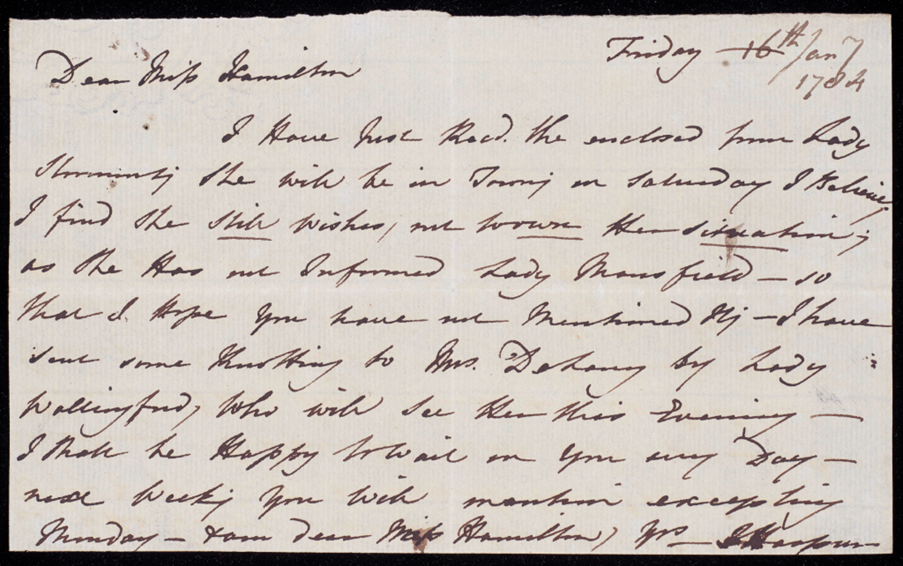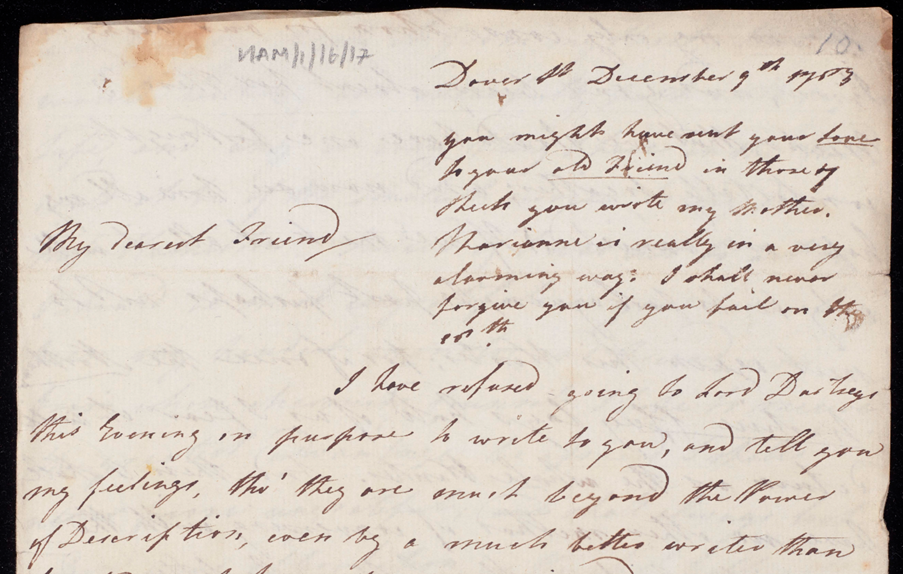In this post, Christine Wallis talks about her experience of using The Mary Hamilton Papers in her teaching at Erlangen. She confirms what we found in the 'Image to Text' project several years ago, that students not just adore working with the Papers but learn a lot by doing so.
Since working on the Hamilton project I have spent two semesters teaching History of English at Friedrich-Alexander Universität in Erlangen-Nürnberg. For spring semester 2021 I was asked to give a course on language variation and change, and it seemed an excellent opportunity to create some teaching materials from the Hamilton letters I had been working on.
The Course
The course I gave was Historical Sociolinguistics, exploring the relationship between language and society in the past. Some of the topics that interest historical sociolinguists include:
- How does language change?
- Who is responsible for these changes?
- How does language vary according to the age, gender or social class of the speaker/ writer?
- Are there links between somebody’s language use and other aspects of their lives, e.g. education, the social networks they are part of, or the identities they seek to align themselves with?
The Mary Hamilton Papers is an excellent resource for helping students explore these questions.
My course consisted of a two-hour lecture/seminar meeting each week, together with a separate one-hour session designed to offer extra practice alongside the main class. We focused mainly on Late Modern English (c.1700-1945), partly because the students had different levels of experience working with historical Englishes (my class included BA, MA and teacher training students), but also because there are excellent surviving texts from this period by a wide variety of writers.
One form of evidence which is widely used by researchers in Historical Sociolinguistics is the ego document – texts such as personal letters and diaries (exactly the kinds of materials available in The Mary Hamilton Papers). For periods before the invention of sound recordings, ego documents are believed to be the closest we can get to people’s everyday speech. As well as learning about the theories and methods that underpin Historical Sociolinguistics, one of my aims in teaching the module was to get the students to investigate real-life data so they could undertake some research into language variation and change for themselves. To do this, each week I introduced them to a different linguistic corpus or dataset, and gave them problems to solve that explored texts by writers from a range of social backgrounds.[1]
Using the Hamilton Papers
I used letters from the Hamilton Papers in three classes. In the first, the class explored language and gender using letters written by four women: (Mary Hamilton, Eleanor Glover and Mary Ann Napier from the Hamilton Papers, and a letter by Ann Leland from the forthcoming Letters of Artisans and the Labouring Poor corpus being created at the University of Lausanne). The first task was to find biographical details about each writer, using resources like the Hamilton archive catalogue. Secondly, students examined the linguistic features in each letter, commenting on whether they were standard or non-standard English, and why they thought each writer wrote the way she did. The writers were chosen carefully to present a range of writing styles from the period: while all three Hamilton writers are upper-class women, Glover and Napier include lots of spelling variation (including Scots features for Napier). Ann Leland, a pauper writer, also uses many non-standard features, but shows far less familiarity with writing on a regular basis. The aim of this exercise was to show how varied women’s writing can be, and how different factors might contribute to writing style, for example, class and access to education, as well as gender.
For an exercise on intra-writer variation, the class looked at letters from Francis Napier. They examined Napier’s consistency in writing (spelling, grammar, syntax), either within the same letter, or between letters written at different periods of his life. The students then referred to resources such as the Oxford English Dictionary, Dictionary of the Scots Language, and Francis Grose’s Classical Dictionary of the Vulgar Tongue to investigate words that they thought might be slang, Scots or otherwise unusual. They also looked at metalinguistic discourse (comments about language). Napier is a lively correspondent with quite a lot to say about language and education, and this exercise showed the class how they could investigate language attitudes and variation over a single writer’s lifetime.
Transcribing letters
The third exercise took place in the practice sessions. For the first weeks of the semester I set reading assignments designed to prompt the class to think about how linguists turn texts into resources suitable for linguistic enquiry (e.g. corpora). This reading was to prepare the students to undertake their own transcriptions, and to make them think about the value of preserving textual features that may turn out to be meaningful (e.g. underlining, deletions, alterations).
When we turned to transcribing the letters, we spent time getting used to the handwriting and language. As several of our letters were by Lady Frances Harpur, deciphering her handwriting and idiosyncratic punctuation was no mean feat!

A note by Frances Harpur (HAM/1/16/21)
Students transcribed a letter for homework, and we used the class time to discuss problems or untangle any tricky readings. Following this, I introduced some of the basic TEI XML tags to incorporate into the transcriptions. Each week I introduced further tags, and the class improved their reading ability and gained confidence with the letters.
I had held back one letter for our last session. HAM/1/16/17 was catalogued as being written by Frances Harpur, but I realised it was in another hand

Letter by William Wake, mis-catalogued as written by Frances Harpur (HAM/1/16/17)
I set this as a detective puzzle: could the class analyse the letter (handwriting, punctuation, spelling, salutations, topic), and decide whether it was in fact written by Frances Harpur? Their emphatic verdict was that it was written by someone else. The handwriting, punctuation, salutations and topic were all different from Harpur’s other letters:
- ‘That’s not Frances Harpur’s writing! She doesn’t do her letter <d>s like that.’
- ‘She never addresses Mary as “My Dearest Friend”, she always writes “Dear Miss Hamilton”.’
- ‘The writer of this letter doesn’t complain enough about their health!’
The students were able to successfully apply the skills they had developed over the semester to give an informed opinion on the letter’s authorship. They found the letters really engaging, and several commented on how much they had enjoyed being able to work with the Hamilton material.
What I hope to have shown here are just some of the ways The Mary Hamilton Papers can be used for teaching purposes. The letters combine well with other corpora and collections covering the period, and the availability of images alongside the transcribed text brings an extra dimension to the material. Since I taught this module we have launched the corpus version of the letters using CQPweb, available via our Text Search page, which could form the basis of further, corpus-enquiry based exercises.
Acknowledgement: Many thanks to the students who participated in the course and made it such an enjoyable semester. Those contributing transcriptions to the project are acknowledged here.
[1] More details of the kinds of datasets I used can be found in Wallis (2020).
References:
Dictionaries of the Scots Language. https://dsl.ac.uk/.
Grose, Francis. 1785. A Classical Dictionary of the Vulgar Tongue. London: Printed for S. Hooper.
Letters of Artisans and the Labouring Poor. Project website: https://wp.unil.ch/lalp/
Oxford English Dictionary. https://www.oed.com/
Wallis, Christine. 2020. ‘Using ECEP (the Eighteenth Century English Phonology Database) as a Teaching Resource.’ English Language and Linguistics, 22(3). 591-606.
